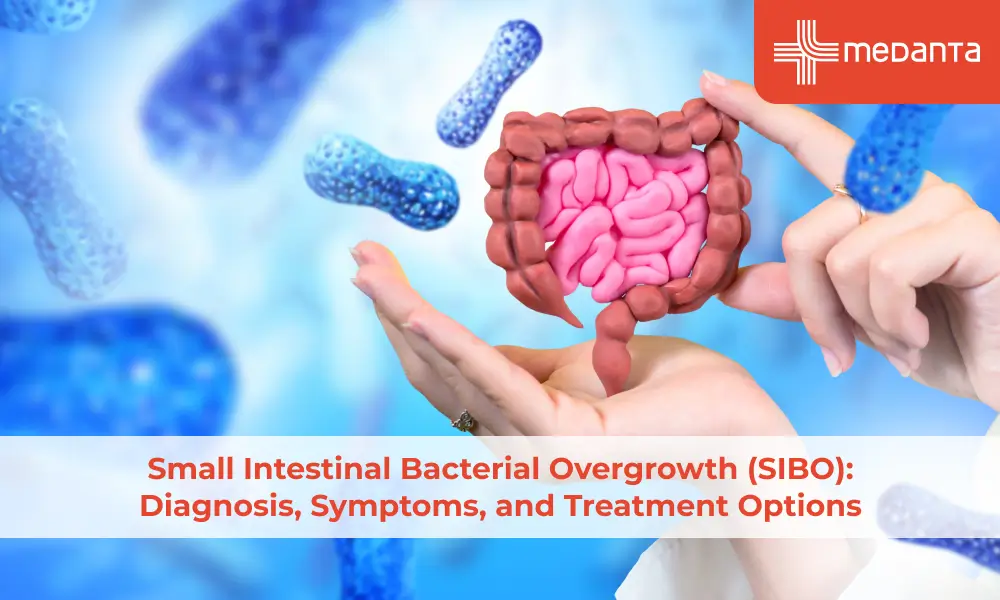Small Intestinal Bacterial Overgrowth (SIBO): Diagnosis, Symptoms, and Treatment Options

TABLE OF CONTENTS
SIBO (Small Intestinal Bacterial Overgrowth) impacts thousands globally as bacteria multiply in unexpected areas of the digestive system. The small intestine spans about 20 feet (6.1 metres) and usually contains few bacteria. The condition develops when bacteria inappropriately colonise this area and disrupt the balance of gut microorganisms needed for healthy digestion.
Slow movement of food & waste through the digestive tract creates perfect conditions for bacteria to thrive. This often happens because of surgery or disease. Patients experience different symptoms, with many suffering from gas and diarrhoea. SIBO cases stem mostly from irritable bowel syndrome, intestinal motility disorders, and chronic pancreatitis - these conditions cause 80-90% of all cases. Antibiotics serve as the main treatment option, yet many patients see SIBO return after completing their antibiotic therapy. The condition can cause serious vitamin and mineral deficiencies that damage bones and the nervous system if left untreated.
Understanding SIBO: What It Is and Why It Happens
A healthy small intestine usually contains a modest bacterial population—fewer than 100,000 bacteria per millilitre. These are mostly gram-positive aerobic or facultative anaerobic bacteria. Your small intestine resembles a quiet neighbourhood compared to your large intestine, which bustles with bacterial activity. This setup exists for a good reason, too: your small intestine absorbs over 90% of nutrients from food. If you have too many bacteria in this area, this crucial process can be disrupted.
To keep this environment balanced, your body develops several protective mechanisms:
Your stomach acid destroys many bacteria ingested by you
Normal peristalsis (wave-like muscle contractions) that pushes contents forward in your gut
With the help of bile salts and digestive enzymes, your body creates an antibacterial environment
You have an ileocecal valve acting as a one-way door. It prevents bacteria from moving backwards in your gut tract
Mucus and secretory IgA in your digestive tract form protective barriers
You have SIBO when there is a breakdown of these natural defences. Any anatomical changes in your gut can be the starting point of this condition. If you have undergone a surgical procedure or have small bowel diverticulosis (pouches in intestinal walls) or the presence of strictures, there is a high chance that you may have stagnant areas where bacteria thrive. Some conditions slow down intestinal movement and let bacteria multiply freely. These include scleroderma, diabetic neuropathy, hypothyroidism, and intestinal pseudo-obstruction.
Low stomach acid (hypochlorhydria) plays a significant role in SIBO development. Age, H. pylori infection, or medications like proton pump inhibitors can cause this. Bacteria that should normally die can survive and multiply without enough acid.
These excessive bacteria create chaos at the time they take hold. They steal nutrients meant for you, especially vitamin B12, which leads to deficiencies. They break down bile salts and interfere with fat digestion. The gases they produce cause bloating and damage your intestine's lining, which makes nutrient absorption even worse.
SIBO's connection to irritable bowel syndrome needs special attention, as studies show SIBO occurs in 43-56% of scleroderma patients. Understanding why it happens remains crucial to make SIBO treatment work effectively.
Recognising the Symptoms and When to Seek Help
Bloating tops the list of complaints among people with small intestinal bacterial overgrowth (SIBO). The condition comes with many other symptoms that can range from mild to severe. People who have SIBO deal with various digestive problems that substantially affect their daily lives.
The digestive symptoms of SIBO include:
Abdominal pain, especially after eating
Uncomfortable bloating and distension
Excessive gas and flatulence
Diarrhoea or constipation (sometimes alternating)
Foul-smelling, greasy stools that may float
Indigestion and nausea
Feeling uncomfortably full after meals
The type of bacteria causing the overgrowth determines symptom patterns. Hydrogen-producing bacteria often lead to diarrhoea, while methane-producing microbes typically cause constipation.
SIBO can demonstrate itself in unexpected ways beyond the gut. These include:
Many patients struggle with fatigue, which can become more challenging than their digestive issues.
People may lose weight without explanation as their bodies struggle to absorb nutrients.
B12 and other vitamin deficiencies can develop and lead to nervous system problems, malnutrition and anaemia.
Headaches, joint pain, and skin conditions might also appear.
Patients have a higher risk of developing kidney stones because their bodies cannot absorb calcium properly
Getting medical help early is vital if you have ongoing digestive issues. Call your doctor if you experience:
Persistent diarrhoea
Rapid, unintentional weight loss
Abdominal pain lasting more than a few days
Foul-smelling stools or visible fat in stools
Severe abdominal pain requires immediate medical attention.
Diagnosis and Treatment Options for SIBO

SIBO diagnosis needs specific testing methods because symptoms often overlap with other digestive conditions.
The hydrogen breath test emerges as the most common diagnostic tool. This non-invasive procedure measures hydrogen and methane gases in exhaled breath after consuming a sugar solution. A rise of 20 parts per million in hydrogen within 90 minutes or methane levels exceeding 10 ppm indicates a positive result.
Small intestinal aspirate culture remains the gold standard to confirm diagnosis despite being invasive and expensive. A bacterial concentration that exceeds 1000 colony-forming units/mL confirms SIBO.
SIBO treatment requires an integrated approach.
Medications: Antibiotics are the lifeblood of treatment, and rifaximin stands out as the really researched option. Rifaximin 1650 mg daily works well for hydrogen-predominant SIBO over two weeks, while methane-predominant cases need a combination of rifaximin with neomycin.
Success with first-line treatment doesn't guarantee lasting relief. About half of all treated patients experience SIBO recurrence after antibiotic therapy. Doctors typically prescribe a second antibiotic course for early recurrences within three months. Later recurrences need retesting before additional treatment.
Dietary modifications:
Low FODMAP diet – restricts fermentable carbohydrates that feed bacteria
Elemental diet – liquid nutrition that's quickly absorbed before bacteria can use it
Meal spacing – waiting at least 3 hours between meals
Nutritional deficiencies need attention, so we focused on supplements for vitamins A, B12, D, E, calcium, and magnesium. Doctors should guide the treatment process, especially when making dietary changes that might create nutritional gaps.
Conclusion
SIBO creates a tough challenge for patients and their doctors. People with this condition face uncomfortable symptoms that disrupt their daily life. Learning why it happens helps explain the challenges in treatment.
Breath tests are a good way to start a diagnosis. Small intestinal aspirate culture gives the most accurate results. Antibiotics are the main treatment option, and rifaximin has shown great success rates. On top of that, dietary changes such as a low FODMAP plan or proper meal spacing can reduce symptoms substantially.
Quick detection and treatment can change everything. If left untreated, SIBO may cause serious vitamin deficiencies that affect your bone health and nervous system. This is why you need to pay attention to ongoing digestive symptoms quickly.
The best way to manage SIBO is through teamwork between you and your doctor. Most people can get substantial symptom relief and a better quality of life with the right diagnosis, targeted treatment, and lifestyle changes. Note that each person's experience is different, so finding the right mix of treatments takes time – but getting better is possible.
FAQs
What are the most common symptoms of SIBO?
The most common symptoms of SIBO include:
Bloating
Abdominal pain
Excessive gas
Diarrhoea or constipation
Feeling uncomfortably full after meals.
Some people may also experience fatigue, unexplained weight loss, and vitamin deficiencies.
How is SIBO diagnosed?
SIBO is typically diagnosed using a hydrogen breath test, which measures hydrogen and methane gases in exhaled breath after consuming a sugar solution. For a definitive diagnosis, a small intestinal aspirate culture may be performed, though it's more invasive and expensive.
What are the main treatment options for SIBO?
The primary treatment for SIBO is antibiotic therapy, with rifaximin being the most researched option. Dietary modifications like following a low FODMAP diet or spacing meals, can also help manage symptoms. Nutritional supplements may be necessary to address deficiencies.
Can SIBO be treated naturally?
While antibiotics are the first line of treatment, some natural approaches may help manage SIBO. These include dietary changes like the low FODMAP diet, herbal antimicrobials such as oregano oil or berberine, and lifestyle modifications to improve gut motility. However, it's essential to consult a doctor before trying any natural treatments.





